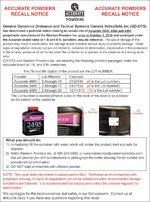Bronze Lifetime
- Messages
- 4,940
- Reactions
- 13,034
That's like nothing I've ever seen before. It will be interesting to see what Hodgdon has to say. Did you send them photos? It might be worth sending photos to the container manufacturer also, see if they have any comment. Something strange happened that I'm sure both of those manufacturers would want to be aware of.
Undoubtedly so. It's bizarre that the lids disintegrated, but the powder is intact. You might want to hang onto the powder until you hear back from Hodgdon, in case they want to inspect it somehow. That's unlikely because you can't really ship it to them, just an idea.We need a chemist, clearly this is some kind of chemistry taking place.













